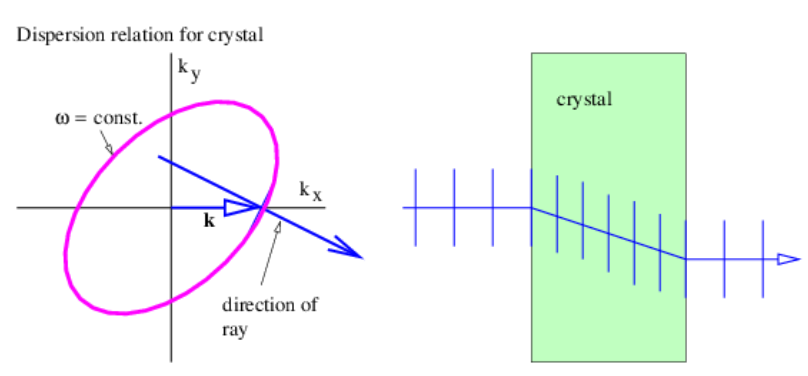3.3: Anisotropic Media
- Page ID
- 32934
Notice that Snell’s law makes the implicit assumption that rays of light move in the direction of the light’s wave vector, i. e., normal to the wave fronts. As the analysis in the previous chapter makes clear, this is valid only when the optical medium is isotropic, i. e., the wave frequency depends only on the magnitude of the wave vector, not on its direction.
Certain kinds of crystals, such as those made of calcite, are not isotropic — the speed of light in such crystals, and hence the wave frequency, depends on the orientation of the wave vector. As an example, the angular frequency in an anisotropic medium might take the form
\[\omega=\left[\frac{c_{1}^{2}\left(k_{x}+k_{y}\right)^{2}}{2}+\frac{c_{2}^{2}\left(k_{x}-k_{y}\right)^{2}}{2}\right]^{1 / 2}\label{3.4}\]
where c1 is the speed of light for waves in which ky = kx, and c2 is its speed when ky = -kx.

Figure 3.3 shows an example in which a ray hits a calcite crystal oriented so that constant frequency contours are as specified in equation (\ref{3.4}). The wave vector is oriented normal to the surface of the crystal, so that wave fronts are parallel to this surface. Upon entering the crystal, the wave front orientation must stay the same to preserve phase continuity at the surface. However, due to the anisotropy of the dispersion relation for light in the crystal, the ray direction changes as shown in the right panel. This behavior is clearly inconsistent with the usual version of Snell’s law!
It is possible to extend Snell’s law to the anisotropic case. However, we will not present this here. The following discussions of optical instruments will always assume that isotropic optical media are used.


